This is the Colonial history leading up to the American Revolution. Why did the residents of England make the dangerous journey across the ocean to a difficult terrain, to begin a new life from scratch?
Colonial History: Pre-British Colonization
The earliest voyages to America were long before Columbus’s voyage, and most definitely before any colonies were established. However, in the 1500’s, several European countries sent explorers across the ocean looking to expand their empires and wealth, which started a competition between several countries to see who would be the first to establish dominance. The next century saw the greatest powers of the 16th century vying for a place on the newly “discovered” continent.
Before long, shiploads of people made the dangerous month-long voyage across the Atlantic Ocean, setting up colonies. Compared with the ever-growing cities occupying most of Europe, the living conditions of the Native Americans seemed very primitive to the Europeans.
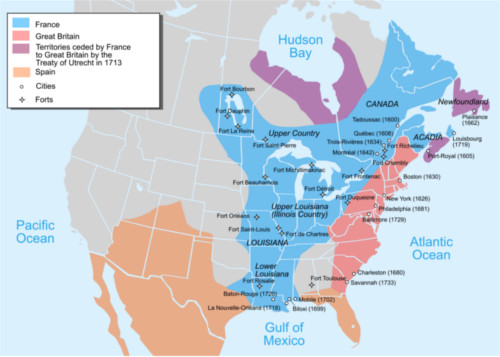
The 1750 possessions of Britain (pink), France (blue), and Spain (orange) in contrast to the borders of contemporary Canada and the United States. Nouvelle-France map-en” by Pinpin – Own work from Image:Nouvelle-France1750.png1) via Wikimedia Commons.
By the time Britain had a successful colony in 1607, France, Spain, Sweden, and the Netherlands were well established. The Spanish had settled in Florida and explored the Southwest, both the continent and the Virgin Islands off the coast. The Dutch started a colony in the north called New Netherland and started a successful fur-trading company that, along with the harbor, created a thriving hub of trading activity. The French settled mostly in Canada, but a few chose Louisiana territory instead. They named their newly claimed land—which stretched from the southernmost coast all the way north to Canada—”Louisiana” after the French king Louis XIV. British colonial history wouldn’t begin until war broke out with Spain.
Spain was the greatest nation in the 16th century. The Spanish King Philip II laid claim to the greatest naval fleet in the world and several colonies across the ocean. England was in civil turmoil after King Henry VIII split with the Catholic Church, and his daughter Queen Elizabeth I was occupied with bringing peace and religious order back to her country. Rather than searching for wealth and expansion across the ocean, she hired privateers to attack Spanish King Phillip’s ships for treasure. Among these are the famous Francis Drake and Walter Raleigh (eventual founder of the failed Roanoke Colony).
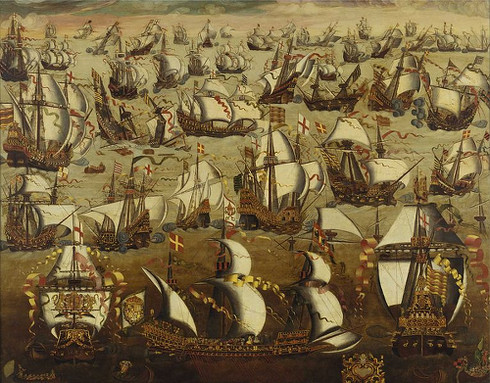
English ships and the Spanish Armada, August 1588.
Public domain image
Frustrated by Elizabeth’s piracy and in an effort to invade England and return it to the Catholics, Philip sent his formidable armada up the English Channel to teach her a lesson, but failed miserably. While terrifying on the open ocean, the Spanish ships were cumbersome and more than half of the 130 ships were destroyed in the process. Philip was sent back to Spain with his tail between his legs.
Tensions grew between Spain and England, and Elizabeth knew that in order to truly rival Spain, she would need to expand her kingdom as well. She therefore allowed her privateers to begin expeditions to colonize the new world. After a few failed attempts due to rough terrain, hunger, illness, mysterious causes, and hostile natives, British colonial history was made and Jamestown was founded in 1607, funded by the Virginia Company.
War officially broke out with Spain, and the new British colony was soon joined by more, populated by the hungry victims of the war with Spain and the many criminals that overfilled the prisons. These ventures were funded by joint-stock companies: investors who bought stock in a low-risk enterprise, usually less involved than a colony, in exchange for a percentage of the profits.
Colonial History: Royal Colonies’ Production & Conflict with the Natives
When the Virginia Company went bankrupt in 1624, the Jamestown Colony was officially declared a royal colony, directly ruled by King James I, Elizabeth I’s successor. The colony had finally seen the worst of colonial history including disease, malaria, and the notorious Starving Time (1 in 6 colonists survived these combined hardships), and were producing enough to survive as well as one particularly lucrative crop: tobacco. The natives had taught the colonists to smoke it, and they believed it to be a cure for colds and illness. Tobacco grew in popularity and increased the colonies’ worth.
Reports were spread exaggerating the colony’s success and encouraging people to sail over and stake a claim in this soon-to-be profitable venture. However, the excessive farming of tobacco (1.5 million pounds were shipped to England annually) began draining the nutrients of the soil. More farms, more labor, more time, and more land were needed. This was a turning point in colonial history. No longer were the colonies struggling to survive; they had begun to thrive.
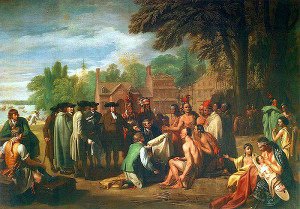
The Treaty of Penn with the Indians depicts William Penn, founder of Pennsylvania, signing a peace treaty with the Native Americans.
By Benjamin West.
This spreading out onto more land created conflict with the Native Americans who already lived there, and especially, who believed that men couldn’t “own” land at all. They attacked the colonies, and the colonies fought back. Most of colonial history is violent, but this was some of the most brutal fights of all. These fights were unfair, since the Englishmen had guns, but the Natives could destroy crops, burn down fences and buildings, and were just as ruthless as the English invaders. More than 90% of the native population was destroyed in the first 50-60 years of English settlement because of this fighting, and unfamiliar diseases brought by the colonists. Later, many were enslaved as well.
The conflict with the Indians wasn’t the only problem caused by the expansion of the colony. The first form of slavery in colonial history began with indentured servants who met this need for more tobacco farm labor by agreeing to work for farmers for a certain number of years in exchange for passage to the new world. These indentured servants often had no life or family to keep them in England, or they needed the work, or they simply wanted an adventure and to escape from England. For more incentive, planters were given acres of land to farm for each indentured servant they brought over. Indentured servants were basically slaves in all but name. They belonged to their owners for years, worked hard all day long, were punished for running away, and had to ask for permission for everything.
This was not the case in the next few colonies. The New England Colony was founded primarily by Pilgrims and Puritans escaping from religious persecution. These are the men and women who sailed over on the famous Mayflower and wrote the Mayflower Compact—the first form of democracy in colonial history.
Colonial History: Government
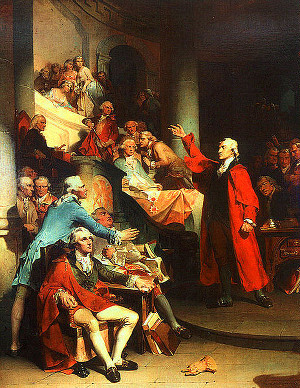
Peter F. Rothermel’s Patrick Henry Before the Virginia House of Burgesses, a painting of Patrick Henry’s “If this be treason, make the most of it!” speech against the Stamp Act of 1765 Public domain image.
The seeds were sown for a democratic nation with the founding of the Jamestown Colony. The colony was technically a royal colony, directly ruled by King James I. They had grown up under British Government ideals, which included direct representation in Parliament. The distance from the mother country required that these colonies have some sort of laws in place and a form of governing each other to avoid utter chaos.
The Jamestown Colony set up a very similar system of government called the House of Burgesses, designed so that a representative of certain areas would make sure the common citizens’ thoughts were heard regarding laws and taxes. Peyton Randolph, Thomas Jefferson, and George Washington are only a few of the great men who served in the Virginia House of Burgesses. This system’s general format was copied by the other colonies.
The voting on the Mayflower Compact formed the basis of a majority voting that wormed its way into the people’s ideals, planting the seeds of democracy. The fact that these colonists had success in creating their own government from the start, albeit underneath another government, was a good portent for the future creation of the government the United States still has.
Colonial History: Religious Persecution
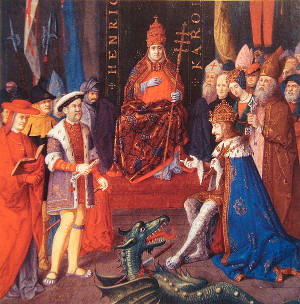
Henry VIII with Charles V and Pope Leon X circa 1520. It was Henry VIII’s split with the Roman Catholic Church which caused so much religious strife in England.
By 16th century painter, anonymous.
Religious persecution was another cause of immigration to the new world. The popular national religion changed each time a new monarch sat the throne. With each change, followers of the less popular religions were ostracized and even arrested on occasion, driving them to seek out a place to worship in peace.
The religious war between the Church of England and the Catholic Church came to a head when King Henry VIII separated England from the Catholic Church because the pope refused to annul his marriage to Queen Catherine of Aragon. While Parliament, after a long period of argument, accepted this new church ruled by the king, many of England’s subjects weren’t so willing.
This religious unrest was partially settled when Queen Elizabeth’s reign brought peace back to England, but after that, every ruler was either considered loyal to the true church or they and their followers were called heretics. This affected colonial history because the “true church” changed depending who was on the throne, and anyone following the “false” church was harassed and sometimes forced to practice their faith in private.
Future colonists began to seek religious freedom. The Pilgrims were sometimes called “The Separatists” for wanting to separate from the Church of England, the nation’s religion while King James (Elizabeth’s successor) was on the throne; whereas the Puritans had a more strict view. Rather than separate from the church, they wanted to purify and purge it, as they felt was not following God’s truth.
Rather than pursue their potentially dangerous ideals where they might be hassled for them, they chose to sail to the new land, create a society more to their liking, and raise their children in peace. King James was delighted to ship off the troublemakers to another continent.
This explains the very religious roots of colonial history. Some of the colonies were begun specifically with religious freedom in mind, and others were little more than power plays and financial ventures. Eventually, all of these colonies would come together to form the 13 colonies.


